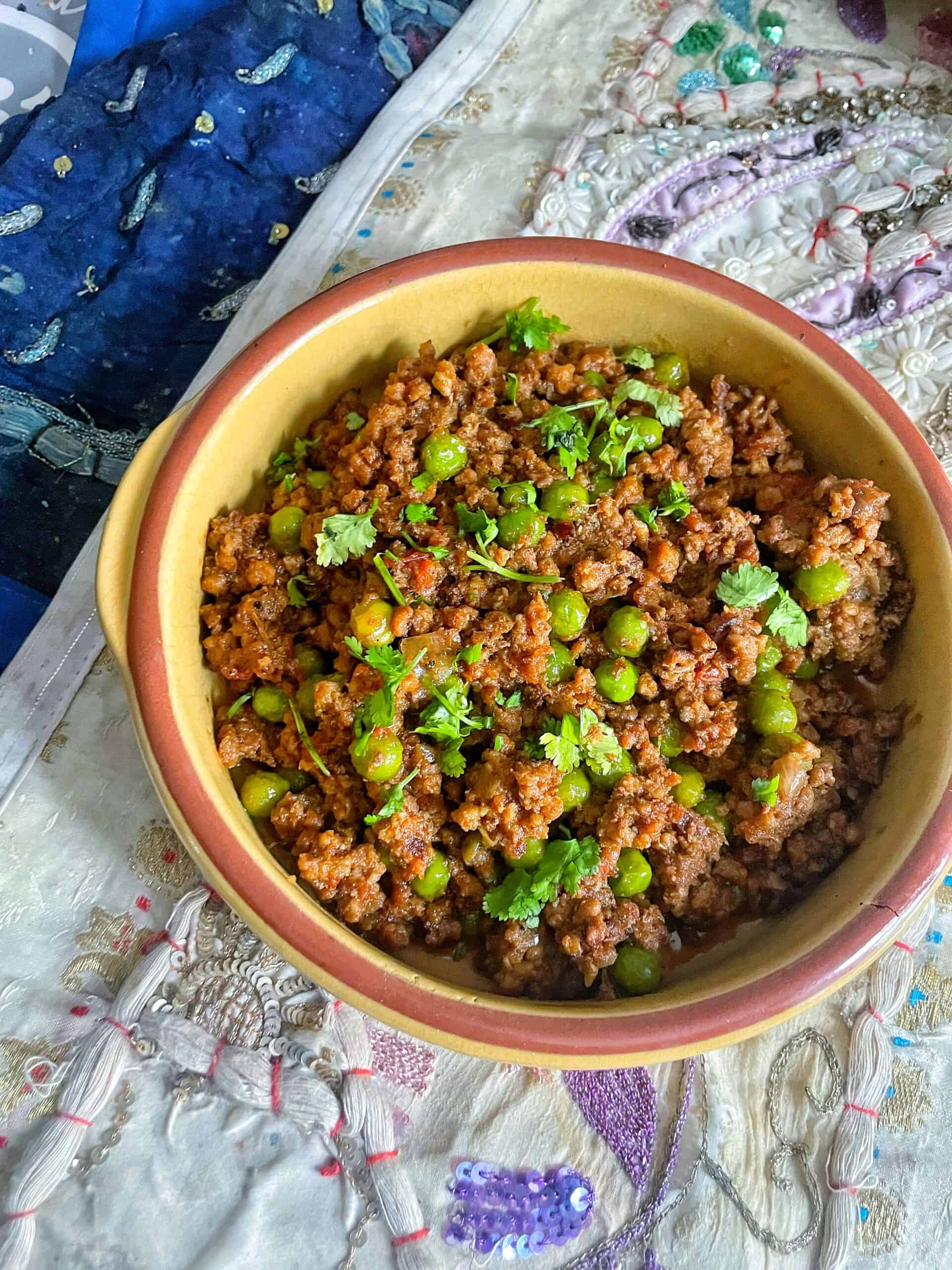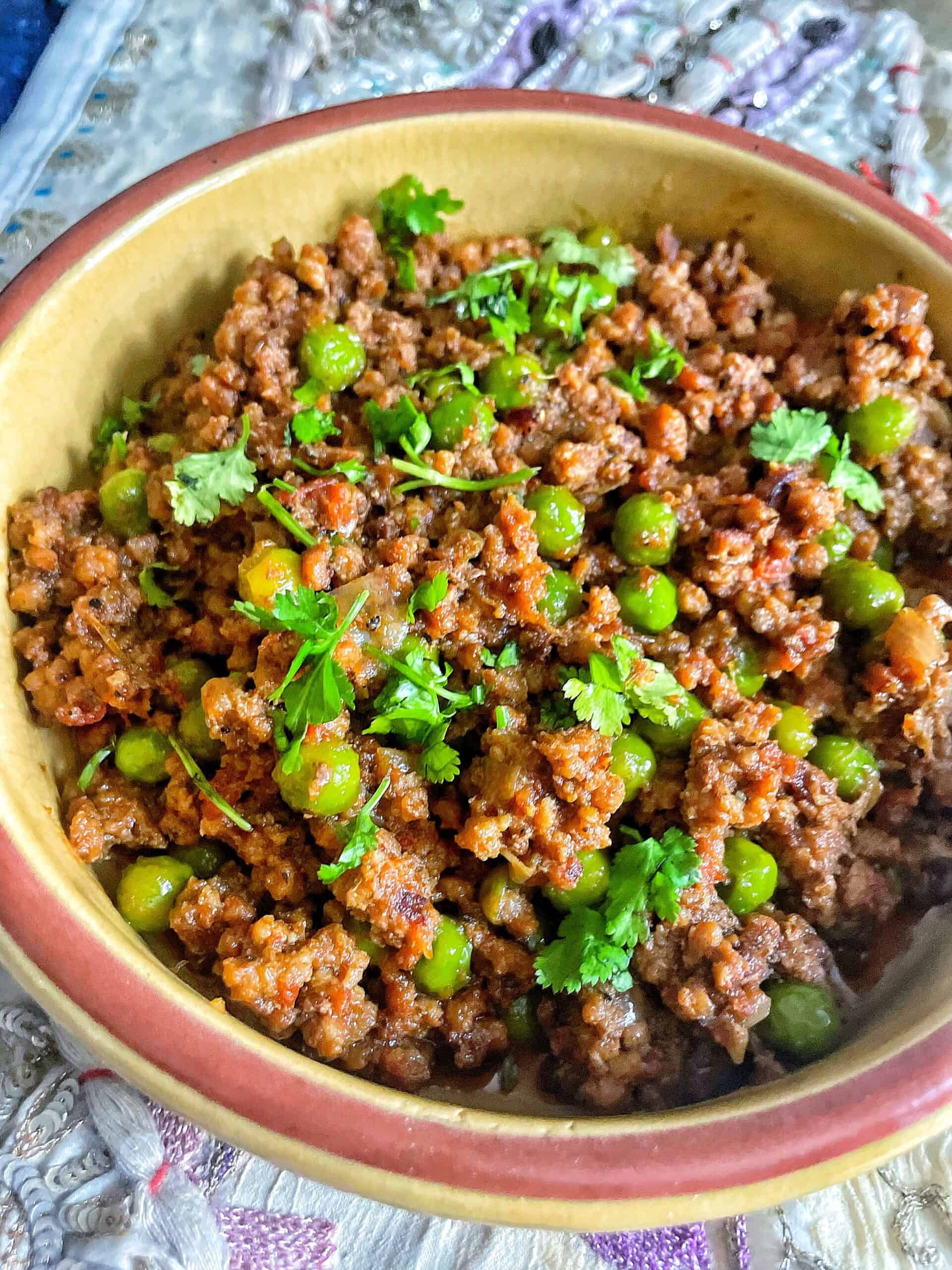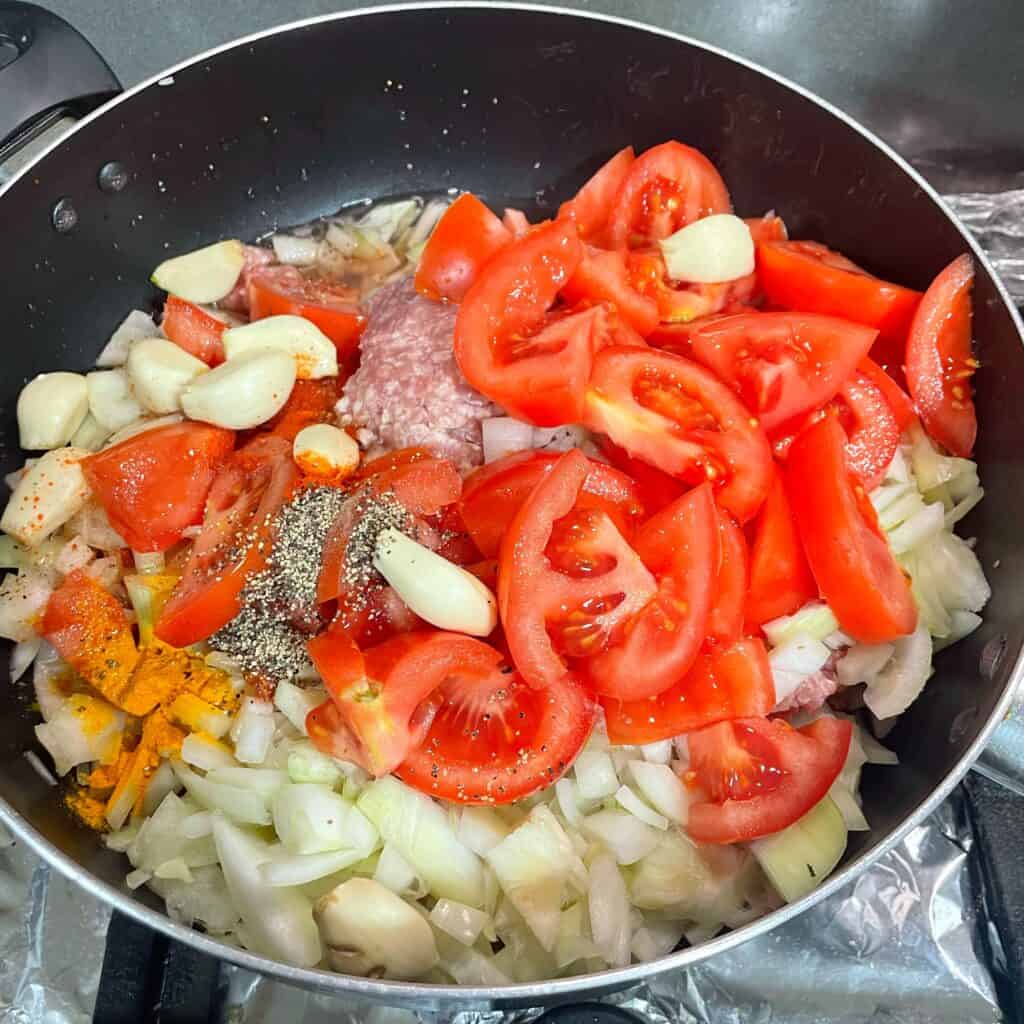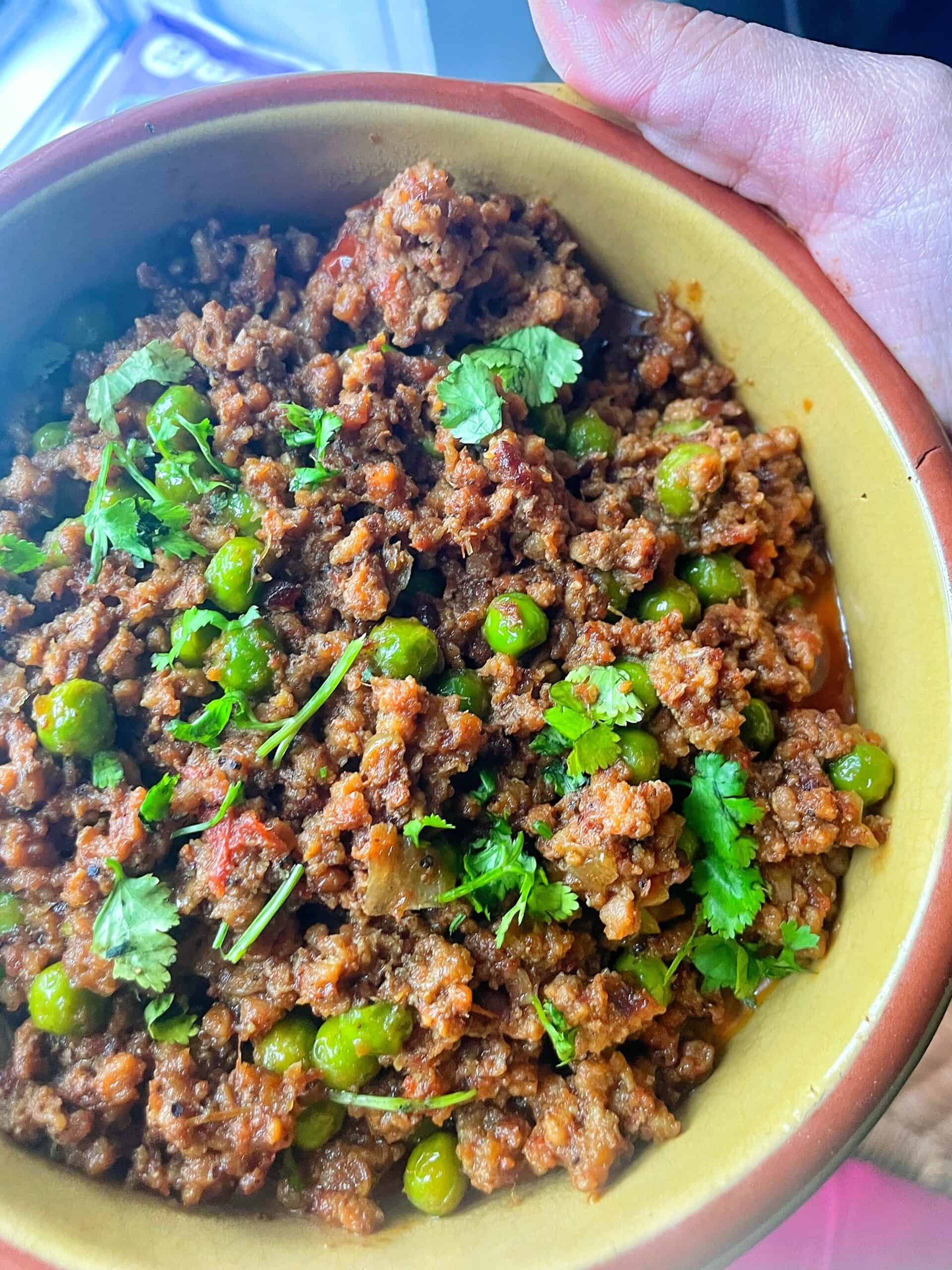This version is the greener, quicker and easier brother to Aloo Keema, which has made an equal number of welcome dinner appearances. It’s a pretty classic, wholesome Pakistani curry - alongside other firm favourites such as Aloo Gosht and Chicken Shorba. I mean, what’s not to love about Keema? To list a few pointers in its favour…
It’s super easy to make - all in one pot, no extra fanciness, no drama, just throw everything into a pot and leave it to simmer with a good bhoon (sauté) towards the end. Not only does it stay in the fridge really well, it freezes wonderfully to. This makes it awesome for meal prep. It is so so versatile. Serve it alongside roti, rice, in a cheese sandwich, between two burger buns, in a tortilla wrap, toss it in some pasta, eat it with a spoon. Is there ANYTHING Keema can’t do? My kids LOOOOOVE this stuff. Including the one year old! Like, he literally eats it with his bare hands. There’s delicious green peas. Don’t like them? Take them out - this recipe is still just as good!
What kind of meat is best in Keema?
Living in the UK, lamb has always been our preferred red meat of choice simply due to availability, cost, and because my Mum had an inexplainable aversion to beef. My preference for lamb has stuck over the years. It’s flavourful, meaty and has this depth that can’t really be replicated by chicken, which is why I rarely cook with chicken keema. Goat/mutton is also GREAT too! I am aware it is the more common red meat used in Pakistan. So is beef. Honestly, it’s your Keema, and your choice of meat. In terms of the texture of the keema you get, you can either get very fine minced meat which has been passed through the mince machine, or a chunkier haath ka keema, which is minced meat cut by a butcher using their own knife. My personal preference is haath ka keema - I like the meaty bite you get from the chunky texture. You are free to choose which once you and your family prefer. This recipe can be used for all kinds of meat. Here is how cook times vary for different meats in comparison to lamb (which is what I’ve used in this particular recipe)
Chicken will call for a reduced cooking time, and no water added Mutton/goat will need a slight bit longer to cook, as well as a bit more water than lamb Beef will take the longest to cook out of all meats, requiring significantly more water (and patience).
I’ve included cook times for all these meats in the recipe card below.
How to make Keema
This recipe is SO easy! Start off by adding in all the ingredients listed in the recipe card to a deep pot or pan aside from the oil, peas and fresh coriander. Add in some water (all the quantities are listed in the recipe card below), cover with a lid and allow everything to simmer for between half an hour to 2.5 hours, depending on the meat you have. Check in every 15-20 minutes, stirring to ensure the ingredients are well mixed, nothing is burning and that no water top-up is required. Once the time is up, take the lid off and turn the heat up to high. Begin to dry off any excess moisture remaining. Once things begin to look dry, add in the oil and continue to sauté the minced meat until the oil begins to separate and rise to the top/edges. You’ll need to stir constantly during this time to ensure nothing sticks to the bottom of the pan. Above is a before and after of the keema - before any sauteing and addition of oil, and after all the sauteing. You can see how all the large bits of ingredients like the onion have all broken significantly and how everything is looking more like a curry. You want to dry this out even further than the image - you essentially want to dry it out so much it looks like you couldn’t possibly dry it out any further! If you’re adding peas: Once the oil has risen, add in the peas and some water. You see how dry the keema looks in this image below? That’s how much you want too saute the keema out before proceeding to this step. Cover with a lid, turn the heat to low and simmer for 10 minutes. Your Keema is ready! Garnish with fresh coriander before serving.
The ultimate tip for all Desi cooking… but especially for Keema
You’ve possibly heard this from your Mum, Dadi, Nani or Phuphi. All the real flavour comes from the bhoon. If you don’t sauté your curry properly it will taste incomplete and won’t get that satisfying colour. If you know, you know. So guys, please don’t skimp on that bhoon-ing action. Really get in there, allow the water to dry fully, keep stirring it till you feel like you can’t dry it out even more, and then sauté it some more. This will take some time, but it is where all the magic is happening. Trust me, a curry even with a simple spicing of salt, chilli and turmeric can taste brilliant if you get that bhoon right. Otherwise, no fancy concoction of exotic spices can save you. The reason why this is SUCH an important part when cooking Keema is because Keema does tend to hold onto a certain ‘undone’ taste if it isn’t fried properly. Like, it’ll essentially be boiled minced meat. Who eats boiled minced meat? Literally no one. A good, thorough bhoon also helps those pesky pieces of onions, garlic and tomato disintegrate into the curry, so you’re not left with stray pieces. Some people may not mind those in their curry, but many people do and the best way to eliminate those, alongside making sure you chop your ingredients finely, is the holy bhoon.
More tips to achieve the holy grail of great Keema
I make no secret of this in ANY of my blog posts - use fresh ingredients. It makes a WORLD of a difference! If you’re using peas, know which kind of peas you prefer. This is largely a personal preference. I prefer large garden peas over petit pois, I just feel like they look more vibrant and juicy. It’s good to actually know what you prefer though so you don’t end up with something you’re not totally happy with. In addition, I always prefer to use frozen peas over tinned. They hold their shape better and taste better. I have no experience of cooking with peas from scratch - if you want to use raw peas in the recipe then cook them fully before adding them. I always always always recommend haath ka keema for any kind of keema dish. Haath ka keema is minced meat which has been minced by a butcher using a knife, not a machine. It’s chunkier, has more of a bite and it’s usually more fresh because they have to make it for you on order, as opposed to giving you the minced meat that is on display Get the best quality of keema you can. More on this next
How to get the best quality Keema
The quality of meat really counts for any sort of cooking, but especially so for keema. A lot of people complain about disliking keema because ‘keema smells’. My family has been in the meat industry for almost 30 years and I know A LOT about good meat. And all I can say is, if you have issues with smelly keema that you can’t fix with a good bhoon-ing session, then you aren’t getting good quality meat. That may not be what you want to hear, but that’s honestly the truth. I am so used to fresh, excellent quality meat that one whiff of a mediocre batch of keema is enough for me to know this can’t possibly result in a good tasting meal. But how do you make sure you get good keema if you don’t have family with meat stores? Ask your local butcher when a fresh delivery of meat is coming and try to purchase it on that same day. It’s probably a good idea to befriend someone at your local butchers for this very purpose, otherwise it can be difficult to find this information out. Also, I would advise you to not purchase the keema that is on display. Ask for cuts of keema to be made fresh for you - for chicken, thigh is always more flavourful, and for red meat it’s your personal preference as to whether you prefer the leg or breast.
How can you serve Keema?
How can you not? Lol. Seriously, this baby is SO darned versatile! Like I mentioned above, it’s great served alongside roti, rice, in a sandwich, in pasta… the list goes on! It’s basically one of the BEST curries you can make if you’re after efficiency! It’s an absolute favourite of ours to serve in a toastie the next day with some cheese! If you want to serve it alongside other Pakistani dishes as a spread, I would recommend balancing it with a more soupy dish, since Keema is more of a ‘dry’ curry. For a homely, weeknight meal I’d recommend a Tadka Dal or Chicken Shorba. For something a bit more more-ish, Aloo Gosht is always a winner! I hope you enjoy this recipe just as much as I have enjoyed it growing up! With love x
📋 Recipe
Enter your email & I’ll send it right over. Plus, you’ll get bonus Pakistani food-goodness from Fatima Cooks, like new recipe alerts, exclusive email-only recipes + more! By submitting this form, you consent to receive emails from me. Your details are secure. Opt-out any time.









